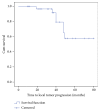Cryoablation of Primary Breast Cancer in Patients with Metastatic Disease: Considerations Arising from a Single-Centre Data Analysis
- PMID: 29201903
- PMCID: PMC5671676
- DOI: 10.1155/2017/3839012
Cryoablation of Primary Breast Cancer in Patients with Metastatic Disease: Considerations Arising from a Single-Centre Data Analysis
Abstract
Background: Patients presenting with stage IV breast cancer might benefit by removal of the primary tumor. We report our experience with CT-guided cryoablation of the primary tumor, with the aim of evaluating its role in this subgroup of patients.
Patients and methods: Data of 35 patients with mean age of 58 years with breast cancer at stage IV submitted to CT-guided cryoablation of the primary tumor between 2010 and 2016 were prospectively evaluated. All patients, except three, were preoperatively and postoperatively evaluated with breast MRI to assess the extent of tumor necrosis. Retreatment was performed in case of incomplete ablation.
Results: Mean tumor size was 3.02 ± 1.4 cm. Six patients had multicentric disease. Complete tumor necrosis was 85.7% and 100% at 2-month and 6-month follow-up, respectively, as 5 patients with tumors > 3 cm required a redo cryoablation. No patient developed major complications. Minor side effects occurred in 30 patients (82%). All patients were discharged the same day of the procedure. During a mean follow-up of 46 months (range 3-84), 7 patients (20%) experienced local recurrences that were treated with redo cryoablation, and 7 (20%) died for disease progression.
Conclusions: Our results suggest that cryoablation of the primary tumor is safe and effective in the treatment of patients presenting with stage IV breast cancer.
Figures




Similar articles
-
Breast cryoablation in patients with bone metastatic breast cancer.J Vasc Interv Radiol. 2014 Aug;25(8):1225-32. doi: 10.1016/j.jvir.2014.05.001. Epub 2014 Jun 16. J Vasc Interv Radiol. 2014. PMID: 24948574
-
CT guided cryoablation for locally recurrent or metastatic bone and soft tissue tumor: initial experience.BMC Cancer. 2016 Oct 13;16(1):798. doi: 10.1186/s12885-016-2852-6. BMC Cancer. 2016. PMID: 27737652 Free PMC article.
-
Real-time magnetic resonance imaging-guided cryoablation of small renal tumors at 1.5 T.Invest Radiol. 2013 Jun;48(6):437-44. doi: 10.1097/RLI.0b013e31828027c2. Invest Radiol. 2013. PMID: 23511191 Free PMC article. Clinical Trial.
-
Percutaneous cryoablation of hepatic tumors: long-term experience of a large U.S. series.Abdom Radiol (NY). 2016 Apr;41(4):767-80. doi: 10.1007/s00261-016-0687-x. Abdom Radiol (NY). 2016. PMID: 26960728 Review.
-
Cryosurgery for primary breast cancers, its biological impact, and clinical outcomes.Int J Clin Oncol. 2019 Jun;24(6):608-613. doi: 10.1007/s10147-019-01448-4. Epub 2019 Apr 13. Int J Clin Oncol. 2019. PMID: 30982153 Review.
Cited by
-
Pre-surgical cryoablation in ≤ 2 cm ER + /HER2-tumors. Prognostic factors for the presence of residual invasive carcinoma.Breast Cancer Res Treat. 2024 Aug;206(3):561-573. doi: 10.1007/s10549-024-07325-7. Epub 2024 May 30. Breast Cancer Res Treat. 2024. PMID: 38814508 Free PMC article.
-
Cryoablation for the treatment of breast cancer: immunological implications and future perspectives. Utopia or reality?Radiol Med. 2024 Feb;129(2):222-228. doi: 10.1007/s11547-024-01769-z. Epub 2024 Jan 31. Radiol Med. 2024. PMID: 38296892 Free PMC article. Review.
-
Cryoablation and immunotherapy: an overview of evidence on its synergy.Insights Imaging. 2019 May 20;10(1):53. doi: 10.1186/s13244-019-0727-5. Insights Imaging. 2019. PMID: 31111237 Free PMC article. Review.
-
Cryoablation for breast cancer: a narrative review of advances, clinical applications, and future challenges.Transl Cancer Res. 2025 Feb 28;14(2):1467-1478. doi: 10.21037/tcr-24-1415. Epub 2025 Feb 26. Transl Cancer Res. 2025. PMID: 40104752 Free PMC article. Review.
-
Interventional oncology and immunotherapy: current status and future perspectives.Front Immunol. 2025 Apr 8;16:1541105. doi: 10.3389/fimmu.2025.1541105. eCollection 2025. Front Immunol. 2025. PMID: 40264767 Free PMC article. Review.
References
-
- Fancellu A., Cottu P., Feo C. F., et al. Sentinel node biopsy in early breast cancer: Lessons learned from more than 1000 cases at a single institution. Tumori Journal. 2012;98(4):413–420. - PubMed
MeSH terms
LinkOut - more resources
Full Text Sources
Other Literature Sources
Medical

